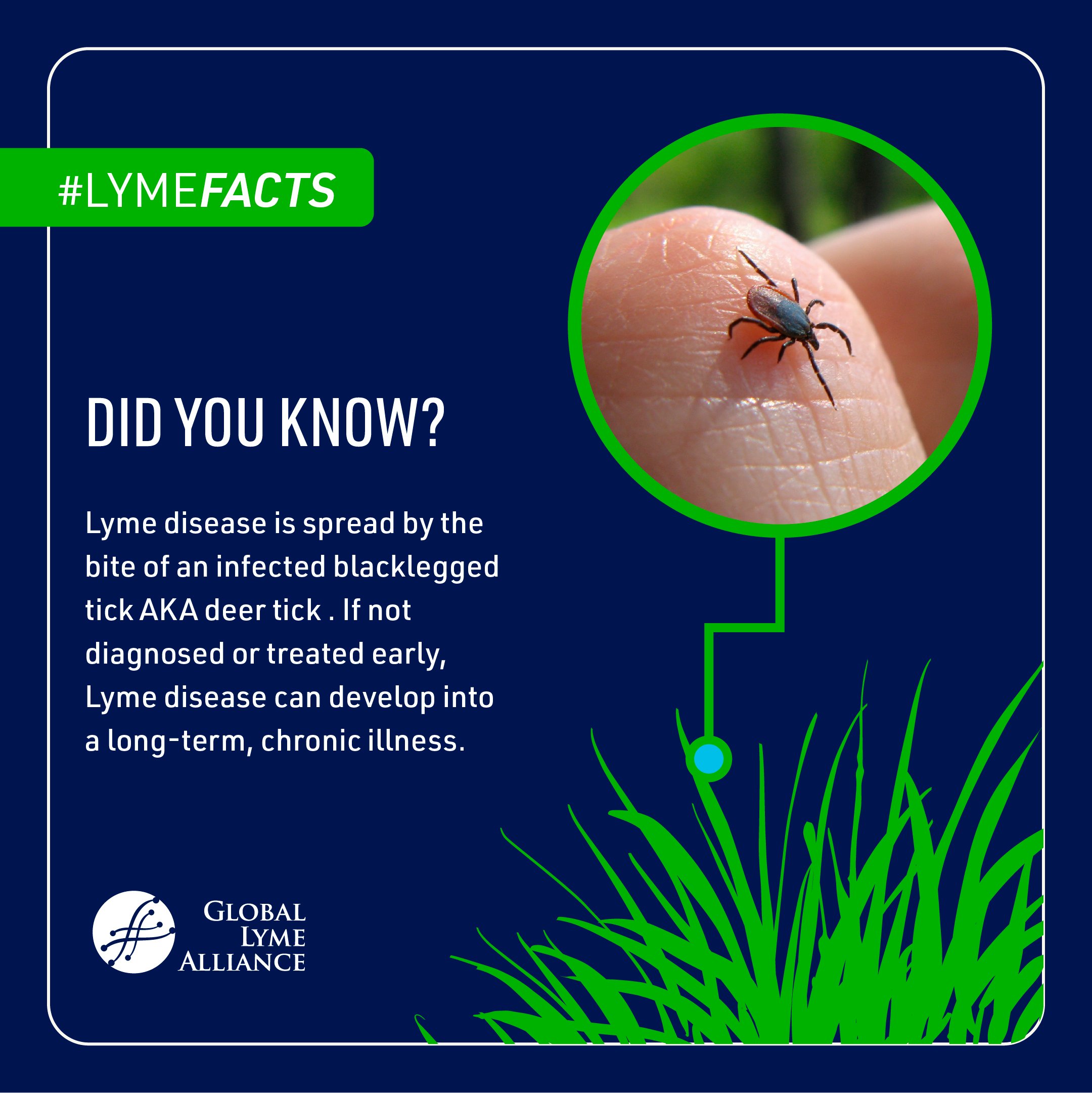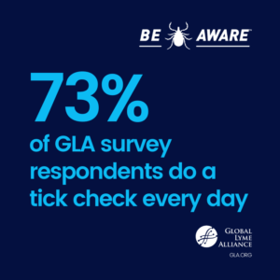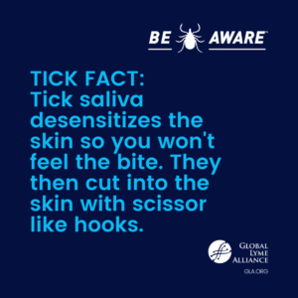
It’s important to follow these simple tips when you find a tick on you, whether it’s attached or unattached
Want to protect yourself from nasty blood-sucking ticks that are rapidly spreading throughout the U.S.? Every year there is an increase in Lyme and other tick-borne diseases, many of which are difficult to diagnose and treat. Right now, the only sure way to prevent infection is to not get bitten by a tick. Indeed, a recent Global Lyme Alliance survey of its constituents found that 93 percent worry about being bitten when they go outdoors.
Let’s say you’ve followed the recommended tick bite prevention measures, but a tick still finds its way on your skin … What should you do?
If you find a tick crawling on you …
 If you spot a tick crawling on your skin and it hasn’t yet bitten you, there’s little to no risk of you becoming ill. A tick transmits bacteria only while it is attached and feeding. If you find one crawling, don’t touch it with your bare hands! You want to avoid touching its mouthparts and coming in contact with the tick’s saliva which may make you sick. See “What to Do with the Tick” below.
If you spot a tick crawling on your skin and it hasn’t yet bitten you, there’s little to no risk of you becoming ill. A tick transmits bacteria only while it is attached and feeding. If you find one crawling, don’t touch it with your bare hands! You want to avoid touching its mouthparts and coming in contact with the tick’s saliva which may make you sick. See “What to Do with the Tick” below.
Be aware though that if you found one unattached tick, there’s a possibility that yet another tick may be crawling on your body searching for a choice feeding spot. Or one may have hitched a ride on your clothes or pet if you have one. So when you come in from the outdoors, shower or bathe as soon as possible. This will wash off any unattached ticks and give you an opportunity to do a complete full-body tick check. As you explore, pay particular attention to the warm, moist places where ticks love to hide: the groin, navel, armpits, between your toes, around the waist, in your hair, behind the ears and knees.
However, if you can’t get to a shower right away, Global Lyme Alliance’s former Director of Education and Outreach, Sara Tyghter, suggests using a lint roller with adhesive paper immediately following your outdoor activities to pick up ticks before they attach. Roll it over your clothing, legs, and arms, just like you would if trying to remove lint or pet hair. “The roller works well for picking up tiny nymph ticks that are hard to see,” she says. “This is a quick way to reduce your risk for a tick bite.” Then shower and do a tick check as previously explained.
If you find a tick attached to you …
We know finding a tick attached to your body can be scary. But please don’t panic. It’s important to properly remove the tick as soon as you find it. The longer it’s attached, the higher the chances it will transmit Lyme disease (studies show that other tick-borne illnesses are transmitted to your bloodstream in a matter of minutes). While there are several folk remedies about how to remove a tick—from covering it in nail polish or petroleum jelly to burning it with a match—ignore them all–these methods may agitate the tick causing it to release its body fluids into your skin, thus increasing the risk of disease transmission.

- Tick Removal. Use fine-tipped tweezers or a special tick-removal tool, such as Bug Bite Thing Tick Remover Tool. Grasp the tick as close to your skin’s surface as possible and pull upward with a steady, slow, even pressure to remove. You may have to pull quite forcefully. You’ll need a really firm hold since ticks are small and nymph ticks can be as tiny as a poppy seed. Do not twist or jerk the tick; this may agitate it and may cause the mouthparts to break off and remain in the skin. Slowly pull straight up until the entire tick (body and head) is removed. If part of the head breaks off when you pull the tick out, try to remove it with clean tweezers. Disinfect the area where the tick was attached (and your hands) with an antiseptic, such as rubbing alcohol. Don’t worry if you absolutely cannot pull it out of your skin, it will eventually work itself out much like a splinter.
- Test the Tick. Send the tick to a lab for testing. It’s important to know what type of tick was attached and what diseases it was carrying.
- Monitor the Bite Site. Take a picture of the bite site as soon as possible. Draw a circle around the bite to easily track if a rash develops and it expands. It’s important to note you may not see a rash or a rash may appear on other parts of the body. Moreover, it may not be in the form of a classic bulls-eye.
- Consult with an MD. We recommend you see a doctor immediately to discuss prophylactic antibiotics as a preventative measure. Write down any symptoms you experience after the bite or use our Lyme Symptom Tracker app to track symptoms. Any changes can mean a reaction to a pathogen from a tick. As soon as you experience any symptoms, call or visit your physician immediately.
- Trust Your Symptoms. Current diagnostic testing is highly inaccurate. Your symptoms may indicate Lyme disease.
What do to with the tick …
 Place the tick in a zippered plastic bag or sealed container with a moist cotton ball or paper towel. We recommend sending the tick to your local health department or a lab to test for Lyme and other tick-borne diseases as well as identification. If you choose not to send the tick to a lab, the CDC suggests wrapping it tightly in tape before disposing of it in the garbage.
Place the tick in a zippered plastic bag or sealed container with a moist cotton ball or paper towel. We recommend sending the tick to your local health department or a lab to test for Lyme and other tick-borne diseases as well as identification. If you choose not to send the tick to a lab, the CDC suggests wrapping it tightly in tape before disposing of it in the garbage.
It is helpful to take a picture of the tick and note the date of its removal for reference. Remember, you can get multiple infections from a single tick bite, and different species of ticks can transmit various infections.
What if you never saw a tick or rash, but suspect you may have Lyme disease …
Many, if not most, people infected with Lyme never knew they were bitten by a tick. One of the first signs of Lyme may be a summer flu-like illness with chills and fever, headache, stiff neck, muscle aches and joint pain. You may also develop a rash anywhere on the body, which may/may not be a circular bulls-eye rash, a well-known early sign of the disease.
If your flu-like symptoms last a few days without any improvement, see a doctor. Request they test you for Lyme disease and other tick-borne illnesses. It’s up to you to let your doctor know you want to be tested. Early detection is key! Lyme and other tick-borne diseases require a doctor versed in their complex symptomatology. Moreover, though current diagnostic tests are unreliable, it’s still a good idea to get tested. Talk to your doctor about taking a prophylactic course of antibiotics. When Lyme goes untreated, it can lead to more severe and persistent symptoms including, neurological and cognitive issues, and potentially fatal heart problems.
What’s most important is the prevention of any and all tick bites. For more on Lyme disease, prevention, detection, diagnosis, treatment, and patient support services visit the BeTickAware.org page to access videos, fact sheets, and a host of educational materials to help keep you and your family safe from tick-borne diseases.
***
Looking for a Lyme specialist in your area? Click here.
To learn more about the stages of Lyme disease, click here.
To learn more about the symptoms of Lyme disease, click here.








